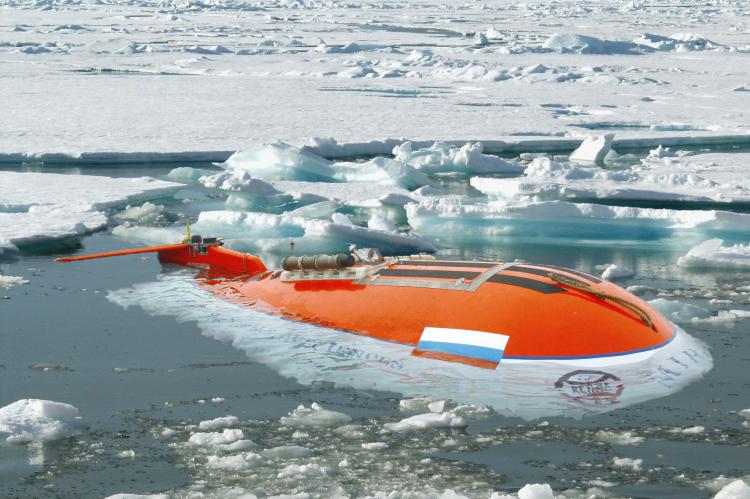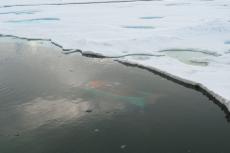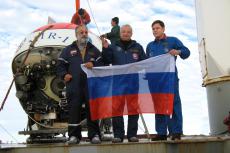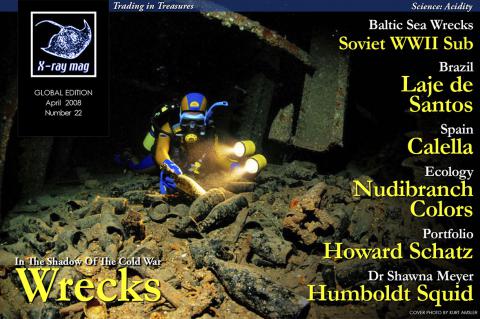Claiming the North Pole
On August 2, 2007, the weather was good at the North Pole. The sea was calm, the water temperature was just -1° C, with the air at a balmy 0° C. That morning two Russian mini submarines, Bathyscaphe Mir-1 and Mir-2, were sent down and at noon, Mir-1 touched down on the seabed at 4,261m, planting the Russian flag
An exclusive interview of Anatoly Sagalevich by the journalist Gleb Cherniavsky.
Gleb Cherniavsky (GC): First of all, our congratulations to you on your achievement. Let me first ask you, when did you get the idea of diving at the North Pole? And how did you get the idea that this was possible?
Anatoly Sagalevich (AS): The idea came to light in 1998. I met Don Walsh and Mike MacDowell who were traveling with a tourist ice-breaker at the time. And they threw the idea to the wind, why not dive on the North Pole? Mike thought it was an impossible idea. But Don told him: “I know one person who just might go along with such an idea,” and brought up my name. Mike then came to our institute, and we discussed this crazy idea. I was instantly captivated. I then had to come up with all the technical solutions. I made some connections with an ice-breaker service in Murmansk and flew up to take a look at their nuclear ice-breaker, Soviet Union. We wanted to put our bathyscaphes, Mir, on this ice-breaker. Its hoisting cranes could manage 25 tons each, and as our bathyscaphes weighs 18.5 tons, it was possible to deploy them from the ice-breaker board.
GC: And which other equipment would you need to support these deep water bathyscaphes?
AS: First of all, we needed to figure out how we could service the bathyscaphes. Doing it outside in the cold on the open deck at the North pole was not an option. The maintenance needed to be conducted under warm conditions. There are a lot different devices, chargers and batteries—they come with four big tool sheds, compressors to fill air, tanks with oil and pumps for hydraulics. And all their devices for wireless and navigation should be in a laboratory. It requires a special technical setup. We really needed to rebuild the ship quite a bit, but you just can’t do that with a nuclear ice-breaker. So, we couldn’t base our bathyscaphes there.
Our regular support vessel, the Academic Keldysh, was undergoing a renovation for other purposes, so we found the diesel-powered ice-breaker, Ivan Papanin, in Murmansk. It had a cargo hold like a football field and two 25 tons cranes. However, the Ivan Papanin wasn’t powerful enough to break very thick ice, so we weren’t sure that it could make it to the North Pole. But we went with it anyway.
Of course, we had no funds, so MacDowell went on looking for sponsors. Even James Cameron became interested in this project, but he was too busy with new movies to become involved. Arthur Chilingarov then joined our project in 2003, and this was a turning point, as Arthur was very experienced with ice-breakers.
For us, the biggest problem was the funding. The price was incredibly expensive. But we decided to aim anyway for a dive expedition to the North Pole in 2007, as this was the International Polar year. We were preparing the bathyscaphes, and safety aspects took a lot of my attention. This project was a leap into the unknown, and we had little idea what lay ahead for us.
We had only a little information from submariners who went under the ice. We only knew that no magnetic compasses would work. Wherever we went, we had to rely on hydro acoustic devices for navigation.
GC: Are you saying that you went to the North Pole without any navigation systems?
AS: Not entirely. We used a navigation system that could relate to hydro-acoustic stations that we hung though the ice. Usually, we put them on the bottom. Also, we developed two hydro-acoustic direction finders that could lead us back to the ship. So we had two navigational systems.
The bathyscapes were powered by three hydraulic engines, but we added two extra electric engines to have auxiliary power in case of an emergency. Our bathyscaphes have to constantly keep moving horizontally. Vertical movement is provided by a ballast system by taking water in and out. Especially for the North Pole, we decide to use a mix 50 percent antifreeze liquid and 50 percent water instead of standard water in ballast system. This was to prevent the valves from freezing, and it turned out to be a very wise decision.
We also added solid ballast (which we had never done before) to save battery energy during ascent in such cold water. We wanted to play it safe and make sure we had enough power in case of a lengthy search for a hole in the ice on the way back.
GC: What kind of battery power did you have?
АS : We had quite a lot of it—about 100 KW-hours. During a regular dive, we would spend most of the battery power on the bottom and leave 10-20 percent for surfacing. We carried a radio that could be used on the surface to call in the mother ship to pick us up. But on the North Pole, the bathyscaphes would be diving under the ice, which meant that nobody could locate us there. We had to find the openings in the ice ourselves.
One of the main questions was how to come back though the same hole in the ice! Just imagine the ice 2-3 meters thick having a small hole about 50 times 30 meters into which you should navigate a 7.8 meter long bathyscaphe from a depth of about 4000 meters.
Download the full article ⬇︎
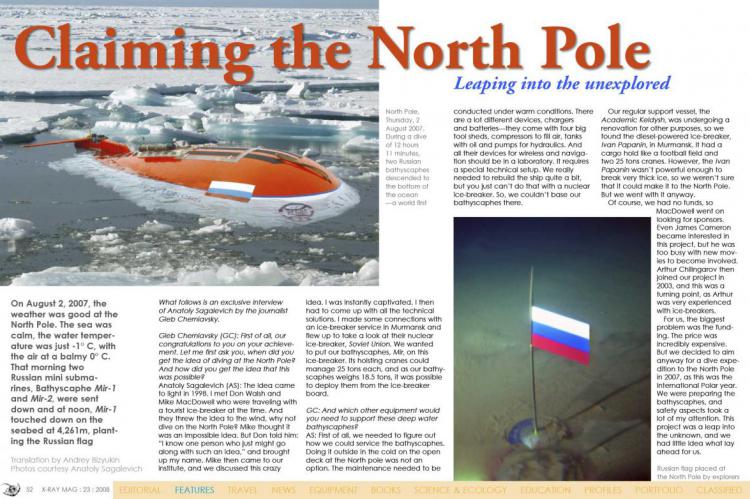
Originally published
X-Ray Mag #22
This issue is packed with stories on wrecks, nudibranchs, sea turtles and sharks. We visit dive destinations at Leje de Santos in Brazil and the picturesque village of Calella on the wild coast of Spain. Arnold Weisz investigates effects of the treasure trade. Learn how carbon emissions is changing the acidity of the seas and the effects on sealife. South African underwater photographer, Fiona Ayerst, reports on the tragic loss of eight Tiger sharks, three of them poached in protected waters. Andrey Bizyukin translates an interview with explorer Anatoly Sagalevich who touched bottom at the North Pole. Cedric Verdier discusses diver safety and rescue in very remote areas. Get a report on Moscow's Golden Dolphin dive show, an inside perspective of IAHD's education for disable divers, Shawna Meyer's close encounter with Humboldt squid, and tips from Kurt Amsler on shooting wrecks. We interview fine art and commercial photographer, Howard Schatz, about his latest book, H2O.



